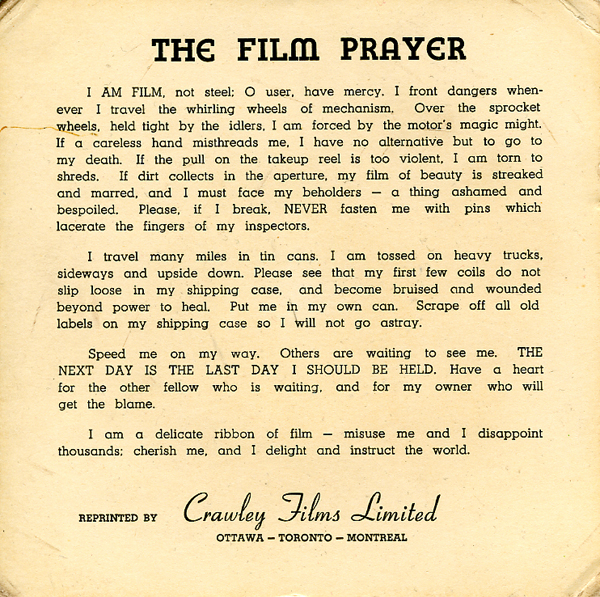The Film Prayer
By Caroline Martel
The Film Prayer: A cautionary tale for projectionists and a mythical document from the analog days found in film cans. Like any piece of folklore that has circulated through our time, its author remains mysterious. For untold decades, as Internet queries reveal, many have wondered about its provenance. [1]
Above, here, we have a material trace of the “Crawley Films Prayer.” Might we speculate that this enchanting viral instruction sheet was, in fact, created by Crawley, a Canadian film production company long recognized for its astute and pioneering use of public relations?
Crawley Films was founded in 1939, the same year as the National Film Board of Canada, with which it immediately started collaborating on training, educational, and informational productions. Frank Radford “Budge” Crawley (1911-1987) was just finishing his honeymoon with Judith Crawley (1914-1986), on which they made their first film together, L’Île d’Orléans (1938) – a travelogue shot on an island in the St. Lawrence River, which they visited upon the recommendation of the ethnologist Marius Barbeau. [2] Their film won the Amateur Cinema League’s award for Best Amateur Film of 1939, marking the beginnings of what would become the longest-running private film company north of the 49th parallel. Crawley grew by making films for government and corporate sponsors, eventually worked for the television sector, and produced countless award-winning animations, documentaries, commercials, and features. The buoyant “Budge” was known to champion the (idea of a) Canadian film industry, adding at the end of the trailer for his features the catch phrase, “A picture every Canadian will be proud to see!”
So, was The Film Prayer another publicity stunt brought to us by the movie maverick Budge Crawley? If the answer is not readily apparent on the Internet, could it be found on the telephone?
I was able to get Glenn Robb on the line, former vice-president and general manager of Crawley Films. He started at Crawley at 18, and worked his way up until the company was sold to Atkinson Film Arts in 1982. Robb began in the laboratory developing and printing film and, indeed, glued the Film Prayer in the inside of film cans. “From about the mid-50s or early-60s, it went into every finished print that we distributed or sold,” he says, adding that there was only one version of the prayer, “a very good little piece,” that was always distributed as, “The Crawley Films Prayer.”
But, who wrote it? At the time, says Robb, Crawley was like “a little Film Board.” “Everybody worked on every film, acting as handymen, even when they occupied higher functions.” However, there was one employee who was “no light guy, no carpenter, but was a salesman with a talent for writing.” This man was Graeme Fraser, the distribution head who joined Crawley immediately upon returning home after World War II, and became the vice-president of sales from 1948 to 1982. According to Robb, he probably even oversaw film scripts, since he was “the editorial type, with an advertising-age style of doing things.” So did Fraser author the Film Prayer, with its witty first-person approach, anthropomorphizing the film? “Everybody knew about the Film Prayer, but no one talked about it. It was just a little thing – that did its magic.” But, Robb wonders, “Maybe Graeme copied it from somewhere…?”
There apparently remained “quite a pile of them in the lab,” located on Fairmount Avenue in Ottawa, but they stopped being used when Crawley went “out of business because video was coming in.” As Robb suggests, maybe there should have been another prayer written “for the film medium itself!”
If its author remains unknown to this day, The Film Prayer’s rhymes still resonate. In one film course that I recently taught, after three attempts to show a DVD, then its backup copy, in three different machines, it occurred to me that maybe The Film Prayer should be invoked. I asked the students if they had heard about it, and they had! Like a legend, made of myth and matter from the past and present, The Film Prayer endures because it speaks to the residual problem of the instability of media, and the recurrent need to mediate the way we interact with them. So before my final attempt to play the optical disc, we read the Prayer out loud in class, to no avail: My Phantom of the Operator (2004) still looked like a self-scratching video. The Film Prayer’s powers, it seems, don’t extend to other media formats.
With all of the daintiness of “new media” (its finicky data-based supports, its fragile bits), perhaps we need – more than ever – some wise and witty words: a new Prayer for the media of our era.
NOTES
1. In 1999, an associate archivist from the University of Pittsburgh reported on AV Media Matters that one of her graduate students came across a film prayer from the Barrus-Cook Film Service: http://cool.conservation-us.org/byform/mailing-lists/av/1999/11/msg00030.html
2. Marius Barbeau (1883– 1969) is considered a founder of Québécois and Canadian anthropology.
ABOUT THE AUTHOR
Caroline Martel is an award-winning documentary filmmaker, artist and researcher who has been synthesizing documentary theory and practice for over a decade, with a special interest in archives, invisible histories, labor and audio/visual technologies and heritage. Her first gallery show, the montage installation Industry/Cinema, was presented at New York’s Museum of the Moving Image in 2012.

